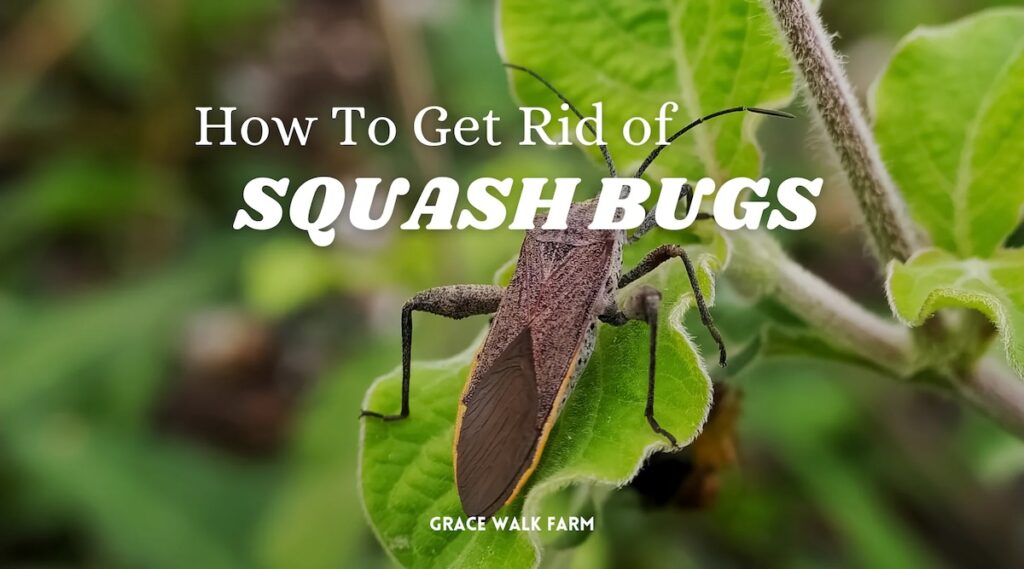Squash bugs are one of the most frustrating pests in the summer garden. They have a little needle-like mouth that pierces the leaves, causing intense damage to your plants and quickly wiping out your harvest if you don’t remove them. So how you get rid of squash bugs?
There are lots of opinions on squash bug control, ranging from “grab some chemicals” to plant nasturtiums to repel the squash bugs. Let’s take a look at the best methods to rid your garden of squash bugs and I’ll share what has worked best for me in my garden.
What Do Squash Bugs Look Like?
Life Cycle: Squash bugs go through a simple metamorphosis with three stages: egg, nymph, and adult. They look a little different at each stage, but they can cause damage at any point. If you see signs of squash bugs at any stage of life, remove them from your plants right away.

Squash Bug Eggs
Adult squash bugs lay clusters of bronze-colored, oval-shaped eggs on the undersides of leaves. The eggs are usually found in a row or in a diamond pattern. Each cluster can contain around 20 eggs.
To remove squash bug eggs, you can gently brush them off with your fingers or use a piece of rolled up tape and pat them. The eggs will stick to the tape and come off without damaging the leaves.

Squash Bug Nymphs
After about one to two weeks, the eggs hatch into nymphs. The nymphs are grayish or greenish with black legs and develop gradually through five nymphal stages (instars). As they mature, they become darker in color.

Adult Squash Bugs
Once the nymphal stages are complete, squash bugs reach their adult stage. Adult squash bugs are approximately 5/8 inch long and have a brown or gray body. They have a distinctive triangular-shaped plate on their back, just behind the head.
Identifying squash bugs is important for early detection and prevention. Look out for the following signs:
- Adult bugs: Look for brown or gray bugs with a distinctive triangular plate on their back. They have piercing mouthparts and emit a strong odor when disturbed.
- Eggs: Check the undersides of leaves for clusters of bronze-colored, oval-shaped eggs arranged in a row or diamond pattern.
- Nymphs: Look for small grayish or greenish bugs with black legs. They gradually develop through several stages, becoming darker as they mature.
Prevention and Organic Treatment for Squash Bugs
It is possible to prevent and treat squash bugs without using chemicals or pesticides. There are several organic gardening strategies that work well to prevent and treat squash bugs. If you need to get rid of squash bugs, here are some strategies you can try.
Don’t Plant All Your Squash in One Place
Try to spread your squash plants around the garden, instead of planting a single “section” or row of squash. I have found that when squash is planted near each other, we struggle much more to control the squash bugs. By spreading out your plants, it helps to prevent a major infestation that can wipe out your crop. Even if one plant gets infested, your others may remain safe because they are not nearby.
Rotate Where You Plant Your Squash
If you plant your squash in the same place every year, you’ll likely see more squash bugs. This is because the sneaky little creatures like to overwinter in the soil. So when spring comes around and you plant your new crop of squash, the bugs are already hiding in the soil waiting to devour it. By moving your plants around each year, you make it less likely that squash bugs will take over and wipe out your harvest.
Check Your Plants and Remove Bugs Regularly
Squash bugs are best addressed with some hard work. Get outside and look at your plants. Search for eggs and nymphs and remove them. When you find squash bugs, drop them in a cup of soapy water or feed them to your chickens. Just get those nasty little guys out of the garden before they do major damage.
Try Row Covers to Prevent Squash Bug Damage
Cover young squash plants with floating row covers to create a physical barrier that prevents squash bugs from reaching the plants. Be sure to remove the covers once the plants begin to flower to allow pollination or pollinate your plants by hand using a paintbrush.

Attract Beneficial Insects
Encourage natural predators like ladybugs, lacewings, and parasitic wasps that feed on squash bugs. Planting flowers, such as marigolds and alyssum, can attract these beneficial insects.
Apply Mulch to Protect the Soil
Apply a layer of organic mulch around the base of squash plants to deter squash bugs from laying eggs in the soil. We mulch with a thin layer of wood chips and it helps prevent weeds and a lot of soil borne pests.
Companion Planting to Prevent Squash Bugs
Plant companion crops like radishes, nasturtiums, or catnip near squash plants, as these can repel or distract squash bugs. I have found that nasturtiums and marigolds are both excellent for repelling squash bugs.
DIY Squash Bug Spray
When we start to see a lot of squash bugs and we can’t keep up with removing them by hand, we make a DIY squash bug spray that works beautifully and it’s safe for organic gardens. Grab a spray bottle or a large sprayer and mix up a solution of 1 tablespoon dawn dish soap, 1 tablespoon Neem oil, and 1 gallon of water. Give it a good shake and then spray your squash plants. Make sure to spray under the leaves too in case there are eggs hiding.
Reapply once a week or as needed. One word of caution – neem can bother bees so don’t spray it on the blossoms. We always spray in the evening, when bee activity is lower to avoid harming our pollinators.
Remember to monitor your plants regularly and take action at the first sign of squash bug activity. Combining preventive measures and organic treatments can help minimize damage and control squash bug populations without the use of synthetic pesticides.
Need more garden help?
Enroll in my new “Backyard Gardening 101″ Course here
Ready to take a deep dive into all things herbs? About a year ago, I signed up for my first course at Herbal Academy and I’ve been digging deep into herbalism ever since. There’s a fascinating world of medicinal plants all around you. Start learning with me here.






